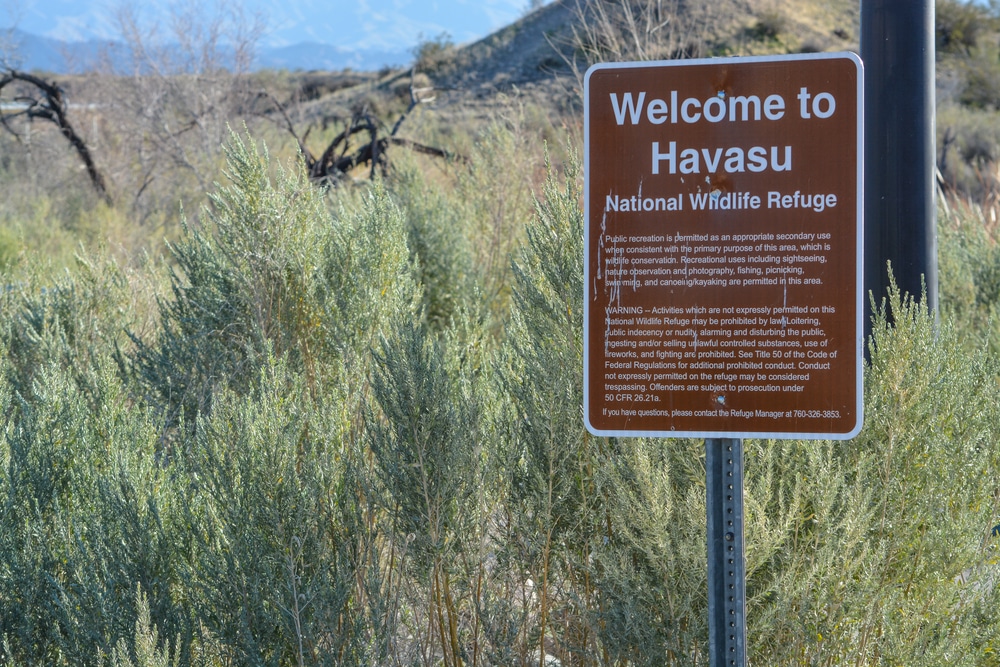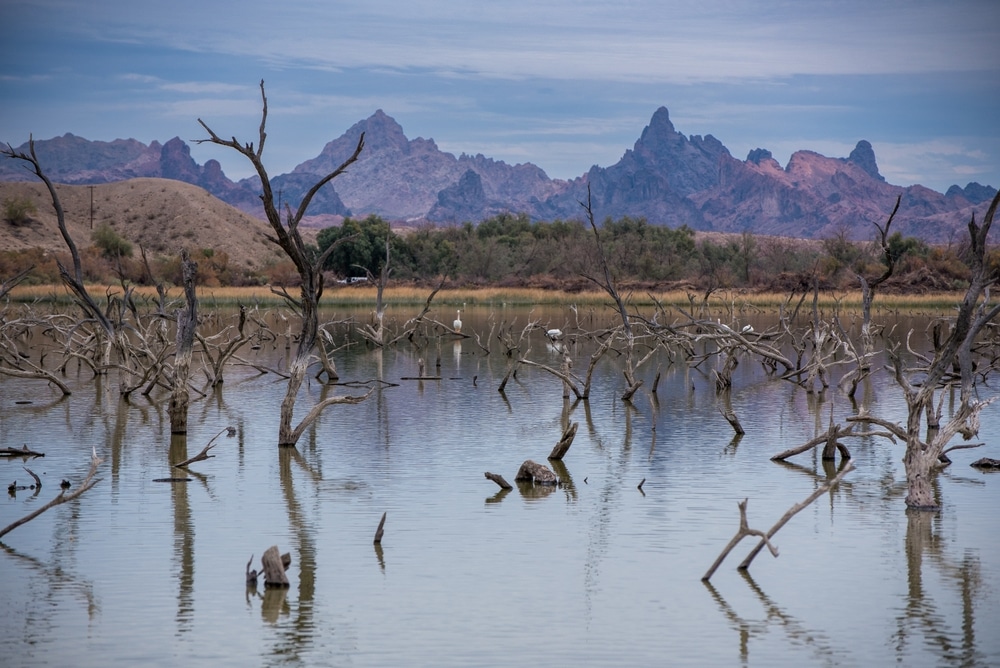In the arid landscapes of western Arizona and eastern California, the Havasu National Wildlife Refuge stands as a vital oasis along the lower Colorado River. Established in 1941 by President Franklin D. Roosevelt, this 37,515-acre sanctuary protects one of the most precious resources in the desert Southwest—water and the rich riparian ecosystems it sustains. Spanning 30 river miles with approximately 300 miles of shoreline between Lake Havasu City, Arizona, and Needles, California, the refuge provides critical habitat for hundreds of species of birds, mammals, reptiles, and fish.
Havasu National Wildlife Refuge showcases the dramatic contrast between the harsh Sonoran and Mojave Desert landscapes and the lush riparian corridors they embrace. Here, in this transition zone between two great deserts, a ribbon of water creates a riparian habitat of marshes and ponds that serves as a crucial stopover on the Pacific Flyway, one of North America’s most important migratory bird routes. The refuge is particularly known for its spectacular Topock Gorge, one of the last remaining natural stretches of the lower Colorado River, and the expansive Topock Marsh, which provides essential wetland habitat in an otherwise arid region.

One of the refuge’s most notable features, Topock Marsh, is a 4,000-acre wetland that serves as a critical habitat for migratory birds and other wildlife. Visitors can enjoy:
The marsh is accessible from North Dike Road and Five Mile Landing, where you’ll find boat launches and parking areas.
The refuge allows regulated hunting in specific areas and during designated seasons. Popular game species include:

The refuge’s waterways are perfect for boating, kayaking, and canoeing. The calm waters of Topock Marsh and the backwaters of the Colorado River provide a peaceful and scenic experience. Paddlers can explore narrow channels lined with cattails and willows, encountering stunning views and abundant wildlife. Motorized boats are allowed in certain areas, though there are speed restrictions to protect wildlife and preserve tranquility.

Fishing is a popular activity at Havasu National Wildlife Refuge, offering excellent opportunities to catch:

While Havasu National Wildlife Refuge is primarily a water-based destination, there are a few areas where visitors can explore on foot:
Be prepared for desert conditions by bringing plenty of water, wearing sun protection, and avoiding midday heat.

The refuge’s diverse landscapes and wildlife provide endless opportunities for photography. Capture:
For the best photos, visit during the golden hours of sunrise or sunset when the lighting enhances the natural beauty of the area.

Havasu National Wildlife Refuge is a haven for wildlife enthusiasts. Its wetlands and riparian areas support over 300 species of birds, making it a premier birdwatching destination. Visitors may spot:
The refuge’s backwaters and marshes, especially Topock Marsh, are excellent birdwatching spots. Early mornings and late afternoons are ideal for wildlife observation.
With its remote location and minimal light pollution, Havasu National Wildlife Refuge is an excellent spot for stargazing. On clear nights, visitors can enjoy breathtaking views of the Milky Way, constellations, and meteor showers. Bring a telescope or simply relax and take in the beauty of the night sky.

| Category | Details |
|---|---|
| Location | Northwestern Arizona and southeastern California, along the Colorado River |
| Established | 1941 |
| Managed By | U.S. Fish and Wildlife Service |
| Size | Approximately 37,515 acres (15,185 hectares) |
| Main Attractions | Topock Marsh, Mesquite Point, and scenic views of the Colorado River |
| Ecosystem | A mix of wetlands, riparian areas, and Mojave Desert habitat |
| Wildlife | Home to over 300 bird species (e.g., great egrets, vermilion flycatchers, and bald eagles), mule deer, coyotes, and endangered species like the Yuma clapper rail and razorback sucker fish |
| Recreation Activities | Boating, fishing, birdwatching, hiking, canoeing, and wildlife photography |
| Popular Areas | – Topock Marsh: A large wetland area ideal for birdwatching and kayaking. |
For visitors, the refuge offers a unique opportunity to witness the incredible biodiversity that thrives where desert meets water. From boating through the spectacular canyons of Topock Gorge to observing thousands of waterfowl during winter migrations or hiking in the rugged Havasu Wilderness, the refuge provides numerous recreational opportunities while maintaining its primary mission of wildlife conservation. This remarkable sanctuary not only protects vital ecosystems but also offers a window into what the Colorado River landscape looked like before extensive human development altered much of the region.
Long before it became a protected wildlife refuge, the area along the lower Colorado River was home to various indigenous peoples who recognized the vital importance of this water source in the desert. Archaeological evidence suggests human presence in the region dating back thousands of years, with tribes such as the Mohave developing sophisticated adaptations to the riparian environment. These early inhabitants utilized the river not only for water but also as a source of food, transportation, and materials for shelter and tools.
The Colorado River served as a critical lifeline through an otherwise harsh landscape, supporting diverse plant and animal communities upon which indigenous cultures depended. Evidence of this long human history can still be found within the refuge today, including petroglyphs visible from the water in Topock Gorge, testament to the enduring connection between people and this vital waterway.
The modern history of protection for this area began in 1941 when President Franklin D. Roosevelt established the Havasu Lake National Wildlife Refuge by Executive Order. The primary purpose of the refuge was to provide and protect habitat for migratory birds along the Pacific Flyway, recognizing the critical importance of this river corridor for countless bird species making their bi-annual journeys.
The timing of the refuge’s establishment coincided with the completion of Parker Dam in 1938, which created Lake Havasu and forever changed the character of the Colorado River. As development and water management projects altered much of the natural flow and habitat of the Colorado River in the mid-20th century, the designation of this refuge helped ensure that some portions of the river’s ecosystem would remain protected.
In March 1975, the refuge was renamed Havasu National Wildlife Refuge and became part of the National Wildlife Refuge System, strengthening its management and conservation focus. The refuge’s boundaries have shifted somewhat over time, including the addition of the Needles Peaks area in 1968, and the separation of the Bill Williams River National Wildlife Refuge as its own 6,100-acre unit in 1993.
The conservation value of the refuge received further recognition with the passage of the Arizona Desert Wilderness Act in 1990 and the California Desert Protection Act in 1994. Together, these legislative acts designated 17,606 acres—approximately 32 percent of the refuge—as the Havasu Wilderness Area. This wilderness designation provides additional protections by prohibiting motorized equipment, mechanical transport, permanent structures, and other developments that would alter the area’s natural character.
The Havasu Wilderness encompasses rugged mountain terrain on both the Arizona and California sides of the refuge, with approximately 14,606 acres on the Arizona side and about 3,195 acres on the California side. This protected wilderness helps ensure that significant portions of the refuge will remain in their natural state in perpetuity, providing undisturbed habitat for wildlife and opportunities for primitive recreation for human visitors.
Havasu National Wildlife Refuge occupies a strategic position along the lower Colorado River, which forms the border between Arizona and California. The refuge extends for approximately 30 river miles from Needles, California in the north to Lake Havasu City, Arizona in the south. This linear refuge encompasses both sides of the river, though the majority of its acreage lies on the Arizona side.
The refuge’s boundaries encompass approximately 300 miles of shoreline, including the main river channel, backwaters, marshes, and adjacent upland areas. On the east, the refuge is bordered by Arizona Highway 95 for much of its length, while various public and private lands form the boundaries to the west in California. Interstate 40 crosses the refuge at Topock, Arizona, providing a major access point.
The refuge can be divided into three distinct geographical areas, each with its own character and ecological significance:
The 4,000-acre Topock Marsh represents one of the largest remaining wetland areas along the lower Colorado River. Located in the northern portion of the refuge, this extensive marsh system provides crucial habitat for waterfowl, wading birds, and various aquatic species. The marsh was formed as a result of the backup of water behind Parker Dam, which created Lake Havasu in 1938, though it has been maintained and managed to maximize its wildlife value.
Topock Marsh features a complex matrix of open water, emergent vegetation, riparian woodlands, and mudflats that change seasonally with water levels. Multiple water control structures allow refuge managers to manipulate water levels to create optimal habitat conditions for various wildlife species throughout the year.
Perhaps the most spectacular feature of the refuge is the 20-mile stretch of river known as Topock Gorge. This narrow canyon section represents one of the last remaining natural stretches of the lower Colorado River that remains in its free-flowing state. Steep, rocky cliffs of volcanic origin rise dramatically from the river’s edge, creating a stunning landscape that attracts thousands of visitors annually.
The gorge’s relatively natural condition provides important habitat for native fish species and riparian wildlife, while its dramatic scenery and geological features make it a popular destination for boaters and nature enthusiasts. Pre-Colombian petroglyphs can be found among the rocks of the gorge, testament to the area’s long human history.
The Havasu Wilderness encompasses the upland desert mountains and bajadas (alluvial slopes) that rise from the river corridor. These rugged landscapes preserve classic Sonoran and Mojave Desert ecosystems, characterized by volcanic mountains, dry washes, and sparse but highly adapted desert vegetation.
The wilderness area extends from the water’s edge up the steep canyon walls along both sides of Topock Gorge and includes significant portions of the refuge’s upland areas. This protected wilderness not only provides critical habitat for desert species like bighorn sheep but also preserves the scenic backdrop that gives the refuge much of its dramatic character.
The refuge experiences the extreme climate typical of the lower Colorado River valley, with very hot summers and mild winters. Summer temperatures frequently exceed 110°F (43°C) between May and October, while winter temperatures generally range from the 40s to 70s°F (4-21°C). Rainfall is minimal, averaging less than 5 inches (12.7 cm) annually, primarily occurring during winter storms or summer monsoon events.
The hydrology of the refuge is dominated by the Colorado River, though its natural flow regime has been significantly altered by upstream dams, particularly Hoover Dam and Parker Dam. Water levels and flows are now largely controlled by dam releases, which affect the timing and extent of flooding in riparian areas. Despite these alterations, the refuge maintains valuable aquatic habitats through active water management, particularly in Topock Marsh where water control structures help maintain appropriate conditions for wildlife.
Havasu National Wildlife Refuge represents a biodiversity hotspot in an otherwise harsh desert environment. The presence of reliable water creates a stark contrast between the lush riparian corridors and the surrounding arid landscapes, allowing for an exceptional diversity of plant and animal life. The refuge lies at the transition zone between the Sonoran and Mojave Deserts, incorporating elements of both these distinctive desert ecosystems alongside riparian communities.
This ecological diversity is reflected in the impressive species counts maintained by the refuge: over 318 bird species have been documented, along with dozens of mammals, reptiles, amphibians, and fish. The refuge has been designated as an Important Bird Area in Arizona, recognizing its continental significance for avian conservation, particularly for species like the endangered Yuma Ridgway’s Rail (formerly known as the Yuma Clapper Rail).
The refuge preserves critical riparian habitat along the lower Colorado River, a habitat type that has been dramatically reduced throughout the Southwest due to damming, water diversion, agricultural development, and urbanization. It is estimated that more than 90% of the native riparian habitat that once existed along the lower Colorado River has been lost or severely degraded, making the protected areas within Havasu NWR all the more valuable.
These riparian zones provide essential ecosystem services, including bank stabilization, water filtration, and flood control. They also create crucial wildlife corridors that allow species to move through the landscape, maintaining genetic diversity and facilitating seasonal migrations. The complex vertical structure of riparian vegetation, from aquatic plants to towering cottonwoods, creates diverse microhabitats that support numerous species at different stages of their life cycles.
The refuge’s location within the Pacific Flyway makes it a crucial stopover for migratory birds, with hundreds of species using its habitats seasonally. During winter months, Topock Marsh shelters thousands of Canada and snow geese, along with numerous duck species. Western and Clark’s grebes raise their young in both Topock Marsh and Topock Gorge, while rookeries in the marsh support breeding populations of herons and egrets.
Year-round avian residents include Gambel’s quail, Anna’s hummingbird, Gila woodpecker, verdin, cactus wren, and phainopepla in upland areas, while riparian zones host black phoebe, common yellowthroat, yellow-breasted chat, and Abert’s towhee. The refuge provides habitat for several endangered and threatened bird species, including the Yuma Ridgway’s Rail, southwestern willow flycatcher, and western yellow-billed cuckoo.
The diverse landscapes of the refuge support a wide range of mammal species adapted to both desert and riparian environments. Desert bighorn sheep inhabit the rugged wilderness areas, moving between mountain ranges and descending to the river for water. Predators include mountain lions, bobcats, coyotes, gray foxes, and kit foxes, while smaller mammals range from desert cottontails and black-tailed jackrabbits to numerous rodent species.
Riparian areas support beavers, muskrats, and raccoons, while the historic mines in the refuge’s wilderness areas shelter thousands of bats, including several species of conservation concern. The complex mosaic of habitats within the refuge allows these diverse mammal communities to find the food, water, shelter, and space they need to survive in this challenging environment.
The refuge’s herpetofauna includes species adapted to both aquatic and desert environments. Notable reptiles include the desert tortoise, a threatened species that digs burrows in upland areas to escape extreme temperatures, and the colorful Gila monster, one of only two venomous lizard species in the world. Various snake species inhabit the refuge, including several types of rattlesnakes, while lizards such as the desert iguana, chuckwalla, and zebra-tailed lizard are common in appropriate habitats.
Amphibians, though less diverse due to the arid conditions, include bullfrogs in aquatic areas and several toad species that emerge during rare rainy periods to breed explosively before returning to underground burrows during dry conditions.
The aquatic habitats within the refuge support both native fish species and non-native game fish. Native species include the endangered razorback sucker and bonytail chub, which can be found in Beal Lake and other managed backwaters. These endemic Colorado River fish have faced severe declines due to altered river flows, habitat loss, and competition from non-native species but receive special management attention within the refuge.
Recreational fishing focuses primarily on introduced game species such as largemouth bass, striped bass, channel catfish, and various sunfish, which provide popular angling opportunities in Topock Marsh and along the main river channel.
Despite its protected status, the refuge faces numerous conservation challenges. Invasive species represent one of the most significant threats, with salt cedar (tamarisk) having displaced native riparian vegetation in many areas. This Asian tree aggressively colonizes disturbed areas along the river, outcompeting native cottonwoods and willows that provide superior wildlife habitat.
Water management presents another major challenge, as the refuge must work within the complex legal framework governing Colorado River water while trying to maintain appropriate conditions for wildlife. Climate change further complicates this picture, with projections suggesting hotter and potentially drier conditions that could stress both aquatic and terrestrial ecosystems.
Other challenges include managing recreational impacts in heavily visited areas, addressing border security concerns, maintaining appropriate fire regimes, and balancing the needs of multiple user groups. Through adaptive management and partnership with other agencies and organizations, the refuge works to address these challenges while fulfilling its core mission of wildlife conservation.
Havasu National Wildlife Refuge offers diverse recreational opportunities that allow visitors to experience its unique natural attributes while minimizing impacts on sensitive wildlife and habitats. All activities are managed with the refuge’s primary purpose of wildlife conservation in mind, ensuring that recreation remains compatible with this core mission.
Boating is one of the most popular activities in the refuge, particularly in the spectacular Topock Gorge. This 20-mile stretch of river bordered by steep canyon walls provides a memorable experience for boaters, who can appreciate both the dramatic scenery and opportunities to observe wildlife such as desert bighorn sheep on the canyon rims and various water birds along the shoreline.
Access to the Colorado River for boating is available at several locations, including Topock Marina in Arizona and Park Moabi in California. Visitors should be aware that certain boating regulations apply within refuge waters, including “no wake” zones in sensitive areas and restrictions on personal watercraft (jet skis) in backwaters off the main channel.
Canoes and kayaks offer an excellent low-impact way to explore both Topock Marsh and Topock Gorge. These human-powered crafts allow for quiet wildlife observation and access to areas where larger motorized boats may have difficulty navigating. Early morning paddling trips are particularly rewarding for wildlife viewing, as animals are often more active during these cooler hours.
Fishing is permitted in accordance with state and federal regulations throughout most of the refuge’s waters, with the exception of areas closed seasonally to protect nesting waterfowl. Popular fishing spots include Topock Marsh, accessible via boat launches at North Dike, Five Mile Landing, and Catfish Paradise, as well as the main river channel in Topock Gorge.
Anglers pursue a variety of game fish, including largemouth bass, striped bass, channel catfish, and various sunfish species. The refuge’s waters are known for producing quality catches, particularly in Topock Marsh where extensive aquatic vegetation and structure provide excellent fish habitat. Fishing is available year-round, though seasonal patterns affect fish location and behavior.
Wildlife observation represents one of the most popular activities on the refuge, with numerous designated viewing areas providing excellent opportunities to spot both resident and migratory species. Pintail Slough, located in the northern portion of the refuge, offers views of wetland habitat where visitors might glimpse waterfowl, wading birds, and occasionally mammals like coyotes or bobcats.
The Bermuda Pasture viewing platform overlooks a large grass field where thousands of snow geese can be seen during winter months. Other notable observation points include North Dike, which offers views of Topock Marsh; Castle Rock, with its 0.2-mile loop trail and beach access; and Mesquite Bay North and South, which feature short walking trails with shaded structures and benches.
Photography enthusiasts find abundant subjects throughout the refuge, from dramatic landscapes and stunning sunsets to diverse wildlife. The interplay of desert and water creates particularly compelling photographic opportunities, especially during the golden light of early morning and late afternoon. Patient photographers may be rewarded with shots of desert bighorn sheep navigating steep canyon walls, ospreys diving for fish, or spectacular flocks of snow geese in flight.
Hunting is permitted in designated areas of the refuge in accordance with federal regulations and applicable state laws. Available hunting opportunities include migratory birds (ducks, geese, mourning doves), upland game (Gambel’s quail, cottontail rabbit), and desert bighorn sheep (by special permit).
Hunting is managed to provide recreational opportunities while ensuring sustainable wildlife populations. Various special regulations apply, including the prohibition of lead shot throughout the refuge (except for bighorn sheep hunts), restrictions on firearm types, and seasonal closures of certain areas. Hunters should consult current refuge regulations and obtain all necessary permits before planning their trip.
While the refuge has relatively few developed trails, it offers exceptional opportunities for wilderness exploration, particularly in the 17,606-acre Havasu Wilderness Area. This rugged landscape allows visitors to experience pristine desert environments with minimal human influence, though hikers should be well-prepared for challenging conditions including extreme heat, lack of water, and difficult terrain.
More accessible walking opportunities include the short trails at Castle Rock and Mesquite Bay, which provide interpretive information and wildlife viewing platforms. The South Dike Road, accessible only on foot, follows the western side of Topock Marsh and offers opportunities to observe sparrows, doves, warblers, and swallows among the marsh vegetation.
The refuge offers guided tours once a month on the second Tuesday from November through April. These tours begin at the North Dike parking lot and follow the dike road through restored marsh, cottonwood/willow, and mesquite habitats. Participants learn about the plants and animals that inhabit the refuge and about conservation efforts underway to preserve this precious resource.
Educational programs focus on the ecological significance of the refuge, the importance of wetlands and riparian areas in the desert Southwest, and the role of the National Wildlife Refuge System in conserving America’s natural heritage. These programs help foster public understanding and appreciation of the refuge’s wildlife and habitats, encouraging responsible stewardship of these valuable resources.
While the refuge is primarily managed for wildlife rather than intensive human use, several facilities help visitors safely enjoy and learn about this unique environment:
The refuge administrative office is located at 317 Mesquite Avenue in Needles, California, and serves as the primary point of contact for visitor information. While there is currently no dedicated visitor center on the refuge, staff at the administrative office can provide maps, brochures, and guidance for planning your visit. On holidays, weekends, and after hours, a self-serve kiosk with refuge information is available outside the office.
Public restrooms are available at the administrative office and at Catfish Paradise, a popular fishing access point. Accessible picnic areas are also available at Catfish Paradise, providing a pleasant spot for a meal with views of Topock Marsh. Five Mile Landing, operated by a concessionaire, offers recreational vehicle and tent camping facilities adjacent to Topock Marsh.
The refuge features several boat launches that provide access to its waters, including free launches at North Dike, Five Mile Landing, and Catfish Paradise for accessing Topock Marsh. These launches do not provide direct access to the Colorado River, which must be accessed via other local launches such as Topock Marina or Park Moabi.
The refuge stretches along approximately 30 miles of the lower Colorado River between Needles, California, and Lake Havasu City, Arizona. Multiple access points allow visitors to experience different portions of this extensive refuge:
To reach the administrative office in Needles, California, from Interstate 40, exit on J Street and go southwest (uphill) for 0.6 miles. Turn right at the refuge entrance sign and follow the signs to the office.
To access Topock Marsh from the north, visitors can take the Oatman/Topock exit from Interstate 40 and follow signs to either North Dike, Five Mile Landing, or Catfish Paradise.
For access to the southern portion of the refuge near Lake Havasu City, visitors can take Arizona Highway 95 to either Castle Rock or Mesquite Bay.
Access to Topock Gorge is primarily by boat, with launch facilities available at Topock Marina (near the Interstate 40 crossing), Park Moabi (11 miles south of Needles), or Lake Havasu State Park at Windsor Beach (in Lake Havasu City).
The extreme desert climate significantly influences the optimal times to visit the refuge. Fall through spring (October to April) represents the most comfortable period for human visitors, with moderate temperatures and pleasant conditions for outdoor activities. This period also coincides with peak waterfowl migration, making it an excellent time for bird watching.
Winter months (December to February) bring thousands of wintering waterfowl to Topock Marsh, creating spectacular wildlife viewing opportunities, especially for snow geese and various duck species. Morning temperatures can be quite cool during this season, so layered clothing is recommended.
Spring (March to May) offers the possibility of desert wildflower blooms following winter rains, adding splashes of color to the desert landscape. This season also brings migratory songbirds moving north along the Pacific Flyway, increasing the diversity of bird species present on the refuge.
Summer (June to September) brings extremely hot conditions, with daytime temperatures regularly exceeding 110°F (43°C). Visits during this season should be limited to early morning hours, and extensive precautions against heat-related illness are essential. Despite the challenging conditions, summer can provide unique wildlife viewing opportunities as creatures adapt to the extreme heat.
The remote location and extreme conditions of the refuge require visitors to take appropriate safety precautions:
Water is the most critical consideration in this desert environment. Visitors should carry at least one gallon per person per day, even in cooler months, and significantly more during hot weather. No potable water is available within the refuge except at the administrative office.
Heat-related illness represents a serious risk, particularly during summer months. Visitors should plan activities for the cooler morning hours, wear appropriate sun protection (hats, sunscreen, lightweight long-sleeved clothing), and know the signs of heat exhaustion and heat stroke.
Navigation can be challenging in remote areas of the refuge, particularly in the wilderness areas where no marked trails exist. Maps, compasses, and/or GPS devices are strongly recommended, and visitors should inform someone of their planned route and expected return time.
Wildlife hazards include venomous reptiles such as rattlesnakes and Gila monsters. Visitors should remain vigilant, especially when placing hands or feet in areas not clearly visible, and maintain a respectful distance from all wildlife.
Boating safety is paramount on refuge waters, where changing water levels, submerged obstacles, and strong currents can create hazards. Personal flotation devices are required by law, and boaters should be familiar with all applicable regulations and navigation challenges.
The management of Havasu National Wildlife Refuge is guided by several key objectives that reflect its mission and the values it aims to protect:
Migratory Bird Conservation: As a unit of the National Wildlife Refuge System established primarily to protect migratory bird habitat, a central objective is maintaining and enhancing habitat conditions for the hundreds of bird species that rely on the refuge during their annual migrations along the Pacific Flyway.
Endangered Species Recovery: The refuge works to protect and recover populations of threatened and endangered species, including the southwestern willow flycatcher, Yuma Ridgway’s Rail, desert tortoise, razorback sucker, and bonytail chub, through targeted habitat management and species-specific conservation actions.
Riparian Habitat Restoration: Given the significant loss of native riparian habitat throughout the lower Colorado River system, the refuge places high priority on restoring and maintaining cottonwood-willow forests, mesquite bosques, and other native riparian communities that provide crucial wildlife habitat.
Wilderness Stewardship: Management of the Havasu Wilderness Area follows the principles of the Wilderness Act, preserving its untrammeled character while allowing for appropriate scientific research and primitive recreation opportunities.
Compatible Recreation: The refuge aims to provide high-quality, wildlife-dependent recreational opportunities compatible with its wildlife conservation mission, focusing on hunting, fishing, wildlife observation, photography, environmental education, and interpretation.
To achieve these objectives, refuge managers employ various habitat management techniques adapted to the unique challenges of this desert riparian environment:
Water Management: Careful manipulation of water levels in Topock Marsh and other managed wetlands helps create optimal conditions for various wildlife species throughout the year. Water control structures allow managers to mimic natural hydrological cycles, creating seasonal mudflats for shorebirds, maintaining appropriate breeding conditions for marsh birds, and supporting diverse aquatic plant communities.
Invasive Species Control: Combating non-native plants, particularly salt cedar (tamarisk), represents a major management focus. Techniques include mechanical removal, selective herbicide application, prescribed fire in appropriate situations, and revegetation with native species. Biological control using the tamarisk leaf beetle has also affected salt cedar populations in recent years.
Native Plant Restoration: Active restoration of native riparian vegetation, including cottonwoods, willows, and mesquite, helps rebuild the complex habitat structure needed by many wildlife species. This often involves site preparation, irrigation during establishment phases, and protection from herbivores until plants are well-established.
Prescribed Fire: Used selectively and carefully, prescribed fire can help restore natural fire regimes, reduce fuel loads to prevent catastrophic wildfires, control certain invasive species, and rejuvenate native plant communities adapted to periodic burning.
The refuge works with numerous partners to extend its conservation impact beyond its boundaries and address landscape-scale challenges that affect the entire lower Colorado River ecosystem:
Multi-Species Conservation Program (MSCP): This collaborative effort among federal agencies, states, tribes, water and power authorities, and environmental organizations works to conserve habitat and work toward the recovery of threatened and endangered species along the lower Colorado River while accommodating current water diversions and power production.
Friends of Havasu National Wildlife Refuge: This non-profit membership organization supports and advocates for the refuge, assisting with events, fundraising, grant acquisition, and volunteer activities that enhance the refuge’s conservation and public use programs.
Arizona Important Bird Areas Program: The refuge’s designation as an Important Bird Area connects it to a global network of sites essential to bird conservation and helps focus attention on protecting its valuable avian habitat.
Indigenous Tribes: Partnerships with tribal nations whose ancestral territories include the refuge area help incorporate traditional ecological knowledge into management approaches and protect cultural resources within the refuge.
Research Institutions: Collaborations with universities and research organizations advance scientific understanding of refuge ecosystems and species, informing adaptive management approaches that respond to changing conditions and emerging challenges.
Havasu National Wildlife Refuge represents a critical sanctuary where water meets desert, creating a haven of biological diversity in one of North America’s most arid regions. As one of the few remaining relatively natural stretches of the lower Colorado River, it preserves invaluable riparian and aquatic habitats that have been lost throughout much of the region due to extensive river development, water diversion, and land use changes.
The refuge’s significance extends beyond its boundaries, forming an essential link in the chain of habitats that support hundreds of migratory bird species along the Pacific Flyway. For the desert bighorn sheep navigating its rugged wilderness, the endangered Yuma Ridgway’s Rail nesting in its marshes, or the razorback sucker finding refuge in its backwaters, Havasu provides the necessary elements for survival in an increasingly challenging environment.
For human visitors, the refuge offers a window into both the natural history of the Colorado River and the conservation challenges facing desert riparian ecosystems in the 21st century. Whether boating through the towering walls of Topock Gorge, watching thousands of snow geese rise from Topock Marsh at dawn, or hiking in the pristine Havasu Wilderness, visitors gain a deeper appreciation for the complex relationship between water, desert, and life in this unique corner of the American Southwest.
As climate change, water scarcity, invasive species, and development pressures continue to intensify throughout the region, the protection and stewardship of places like Havasu National Wildlife Refuge become increasingly vital. Through science-based management, collaborative partnerships, and public engagement, this desert oasis will continue to fulfill its mission of wildlife conservation while inspiring current and future generations to value and protect our shared natural heritage.

We use cookies to improve your experience on our site. By using our site, you consent to cookies.
Manage your cookie preferences below:
Essential cookies enable basic functions and are necessary for the proper function of the website.
Statistics cookies collect information anonymously. This information helps us understand how visitors use our website.
Marketing cookies are used to follow visitors to websites. The intention is to show ads that are relevant and engaging to the individual user.